An architecture student bought a disused church to live in with friends. Then fate struck. Now, four years later, he is creating four starters’ homes from ruins.
This is what the burnt down Juliana Church on Heijplaat should look like next year. (Image: Nima Morkoç)


Never waste a good crisis, they say. Architect and TU Delft alumnus Nima Morkoç put that saying into practice when his enormous shelter went up in flames. Everything is now pointing to the burned out Juliana Church on Heijplaat rising from the ashes as four welcoming and affordable starters’ homes. “The biggest task for our generation of architects is to create affordable housing.”


Garden town of Heijplaat
The exit lane of the A15 spans a large railway yard containing dozens of tracks and switches among them. In the distance, cranes tower above a sea of warehouses and piles of shipping containers. You would not expect a residential area here anymore. Yet, the signboards say that Heijplaat is this way. Behind a large customs building, there are suddenly villas and unexpected green. The Courzandseweg, ‘steak lane’ as it is called by the locals, was built for the Director of the RDM and his staff. Behind it is the ‘meatball’ neighbourhood for the labourers. At its highest point, 3,000 people lived here. Now the population has just about halved. The isolated village was built as a garden town for the personnel of the Rotterdamse Droogdok Maatschappij (RDM, Rotterdam dry dock company). It had everything: homes, schools, shops, a bandstand and three adjacent churches – Catholic, Reformed and Dutch Reformed. Something for everyone.
From 1902, proud seaworthy ships were built here, like the marine cruiser De Zeven Provinciën (the seven provinces, 1953), the huge passenger vessel the S.S. Rotterdam (1955) and countless submarines. The demand in the post-war period was so high that the garden town of Heijplaat was even expanded with the Nieuwe Dorp in the 1950s and 1960s.
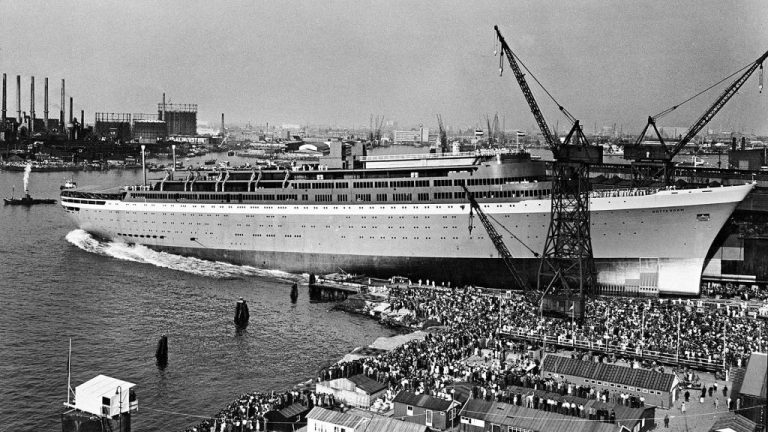

Shortly thereafter the tide turned for RDM that in its heyday was one of the biggest shipyards in Europe. Competition from Japan and Korea, where wages were a lot lower, increased and RDM looked towards the defence and offshore industries to survive. In the end, bankruptcy was inevitable. In 1983, more than one third of the more than 3,000 employees lost their jobs.
For the Heijplaat community, that meant unemployment, poverty and the loss of social cohesion. On top of that, increasing secularisation closed the churches in Heijplaat one at a time, including the Dutch Reformed Juliana Church. The Church had seen so many weddings, baptisms and funerals since 1930. Life’s milestones were celebrated here. But what had long been a meeting place for the believers in the community had lost its function and was empty.


One chance in a million
“Nima, the Church is for sale. You really must come and see it.” Former Architecture and the Built Environment student Nima Morkoç (now 29) was phoned by his father, who lives in Heijplaat, in spring 2017. The Woonbron housing corporation had put the Juliana Church on the market after 10 years of disuse. He was not really interested at first, he says four yers later when we meet in the charred ruins.
Morkoç senior, Nima’s father, still lives in the vicarage behind the Church. He convinced his son that it was a chance in a million to buy the Church and the vicarage together – Nima the Church, his father the vicarage. They signed the contract in March 2017.
Four TU Delft Architecture and the Built Environment friends were interested in moving in: Dominik Lukkes, Matthijs van Mulligen, Stijn van den Berg and Kenzo van Egeraat. The master students would build five tiny houses in the Church to live in. The Church hall would be used for parties, film nights and dinners. There would be space for an art atelier for Nima’s sister Mina (“yes, the names are very confusing!”), who at the time was studying law at Erasmus University.
Just before summer, everyone gave notice on their accommodation and moved their belongings to Heijplaat. The belongings of five students and the contents of an artist’s studio. And there was still space in the Church. After summer they would start on the renovation, but first, holidays.
NL alert
On Sunday 6 August 2017, Nima Morkoç returned from a hiking holiday and dropped by his mother in Blijdorp to do the laundry. It always felt good to be looked after well. A little after 11 that night, his father phoned. “Nima, come rightaway, the Church is on fire!” “Then you need to phone the fire brigade, not me,” Nima joked. But once in the car it became clear that it was no laughing matter. His mobile phone kept beeping with incoming messages and an NL-alert came in at around 23:30. Driving over the Erasmus Bridge he saw a sea of fire and clouds of smoke billowing from Heijplaat across the centre of Rotterdam. The Erasmus Medical Centre had already closed the ventilation inlet.
His father, who was inside the Church trying to put out the fire, was quickly removed by the fire fighters. The fire quickly spread and there were emergency services everywhere. In the end there were 20 fire engines, 40 people had to be evacuated from their homes, and the fire was only under control at about three in the morning.
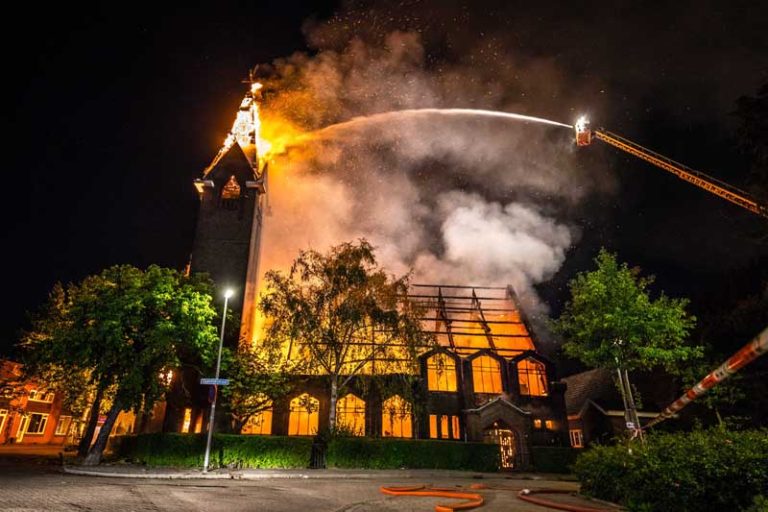

The Rijnmond news website reported on the fire the next day. ‘Rotterdam, 7 August 2017 – The Juliana Church on the Zaandijkstraat in Heijplaat almost burned to the ground on Sunday evening. The fire took hold extremely quickly and spread a lot of smoke that even blowed over the river towards the city centre. There were no victims. The top of the tower – that was made of wood – the roof and the space underneath were completely burned. Only the stone walls and the Church tower are still standing. The building is a write-off.”
“What caused the fire?” is the second most frequently asked question after “Was it for the insurance?”. According to Morkoç, the experts concluded that it was probably caused by a faulty ventilator. The ventilator was wired in parallel with a lamp and, after days or weeks, ignited. The burning lamp was forgotten during the holidays, but nobody could know that there was also a stuck ventilator under electric tension.
The friends were all still on holiday: Kenzo in the Netherlands, Stijn in Columbia, Matthijs in India and Dominik in Detroit. But they were all in the same situation: they had all lost their belongings and were homeless.
“I used to collect a lot of things,” says Nima Morkoç looking back. “I had kept all my notebooks from primary school. I collected stamps, coins and shells. When I last moved, I had 17 boxes of books plus my clothes. After the fire, I was upset about everything I lost for a while. I now have a much more minimalist lifestyle. I now only have three boxes when I move.”




Shortly after that, Nima gave the Stylos study association from Architecture and Built Environment a tour. (Photo: collection Nima Morkoç)
The friends quicky found new housing on the Nieuwe Binnenweg, but for Nima it took at least one month before he could start sketching again and could think about the future.
‘Erotic and intense’
His graduation project landed in his lap – finding a new purpose for the burnt down church. The exercise was far from purely academic. Nima had to work with insurance companies, lawyers and the municipality. He could not live on just his student grant so he earned a little extra by giving tours.
This period was one of losing things, clearing up, studying in between and sleeping in a kitchen. Amid the walls of the burnt ruin, Morkoç and his friends organised an open air cinema, a photo exhibition, a tostitreffen (a toasted sandwich party) and other fun cultural activities.
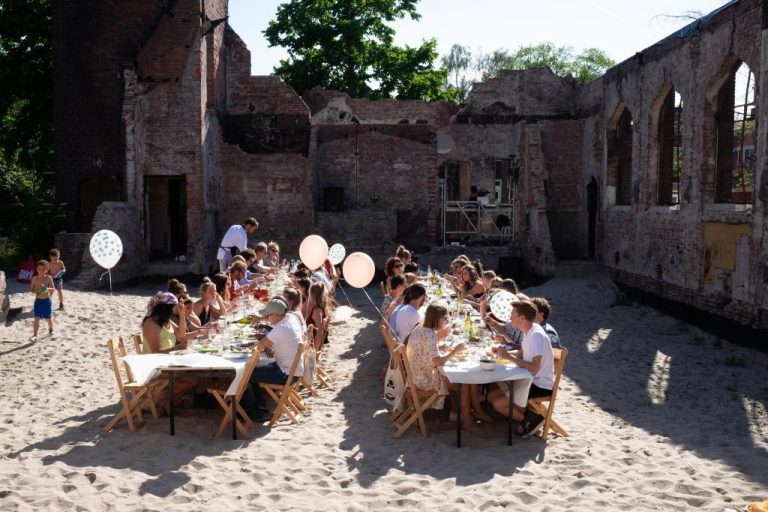

What makes the Church a historic building for its surroundings? This is the burning question in Nima Morkoç’s dissertation, Social Monumentality in 2018. The historic significance did not lie in the building itself that Morkoç describes as ‘a barn with the addition of a bell-tower’. Nor, oddly enough, did it lie in the use: ‘the church was empty for 10 years and nobody seemed to care’.
He discovered that there are about 600 disused churches in the Netherlands at present, and that two join the list every week. The empty religious heritage is such an all-encompassing and complicated issue that a special platform (in Dutch) was set up to share knowledge, networks and experiences.
The issues around the Juliana Church, now called Project Juul, also apply to other churches: the social connections have disappeared, residents no longer pay attention to each other, the cohesion has disappeared and loneliness is on the rise. The question, and the assignment that Morkoç has given himself, is how can the social monumentality of the Juliana Church be restored so as to benefit Heijplaat? It is about restoring social connections that had disappeared long before the fire broke out.
Paradoxically, the fire put the future of the Juliana Church on the map again. The burnt down ruin is attracting attention. “The Church is in the most vulnerable naked phase of its existence,” writes Morkoç, “so whatever happens next will be erotic and intense in both the spatial and the social sense, and will be interesting to see.”
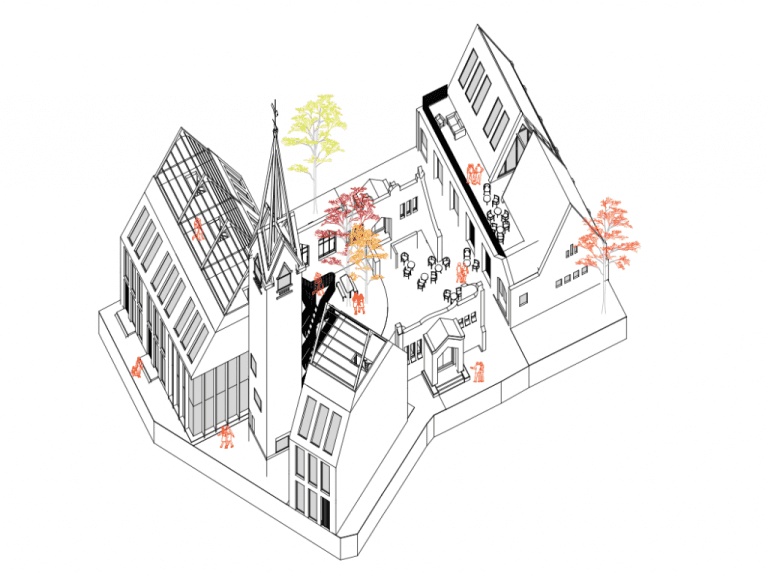

The design for homes around the empty Church from his master thesis. (Image: Nima Morkoç)
After 120 versions, Morkoç came up with a design for living space for students and employees from start-ups on the RDM Rotterdam premises. The living spaces are built round the empty space of the Church. Two blocks, one on either side of the clock tower and one on the site of the vicarage. It is as though the young architect did not dare use the former Church itself at the time. That space, between the old windowless Church walls, will continue to be a meeting place for those living nearby.
He earned a seven for his graduation work.
Affordable housing
After graduating, Morkoç started working as an assistant designer at West 8, a design agency for urban architecture and landscape design where he had done an internship. Last year he moved to Mei architects and planners, an agency that made its name with SAWA, the 50 metre tall completely wooden housing complex. He still keeps one day a week free for the redevelopment of the Juliana Church as a project for his own company, HUM Design & Development.
“It became a sort of traineeship in urban development, architecture, landscape architecture, legal affairs, commercial viability and zoning plans,” he says looking back. Before any plans could actually be made, the zoning plan and the leasehold had to be changed, and the Aesthetics Committee had to give its approval. A new purpose for the Church had to meet all these conditions and the end product also had to benefit Heijplaat. Repurposing into a swimming pool, hotel or shopping centre were not options given the low number of visitors expected, and would therefore not be viable.
After 23 rejections, at the end of 2019 all the lights turned green for Project Juul. In November 2019, the Aesthetics Committee approved the plan and a year later the contractor BIK Bouw signed the building team agreement. Last year the contractor came second in the Rotterdam Architecture Prize with his conversion of the Noordsingel Prison into flats. “If prison is that beautiful, I want to live there too,” responded one voter.
The application for the building permit was submitted last summer. ‘This is very exciting because it means that we can finally take the next steps with Ooms estate agent for the sales. We are in the throes of preparation,’ writes Morkoç on his website.
Morkoç’s strong preference was to repurpose the building into homes. “The biggest task for our generation of architects is to make affordable housing. Everyone I know is finding this difficult.”
This naturally was not in line with the repurposing plan of the Church, but there was room for discussion. Morkoç learned that “you should not be confrontational in discussions with the municipality. You need to involve them in your plan so that their role is ensuring the general quality of the plan.”


The design of four homes inside the contours of the old Church. (Image: HUM design & development)
The municipality preferred larger and more expensive homes for well-off families, but Morkoç’s choice lay elsewhere. He pushed for a design for four compact (110 m2) and affordable homes (around EUR 400,000) within the contours of the Church. The vicarage, where his father lives, is no longer part of the plan.
The homes are designed for modern life and work. The active part of life takes place on the ground floor – cooking, eating, social interaction and a communal open garden. The first floor is for sleeping, and the second floor has a high and spacious workspace. The windows on the outside are rectangular and sleek, in the Reformed Church style. The windows on the courtyard side are bigger and rounder. There are no hedges and the space between the houses is intended to be a meeting place within the seclusion of the old church walls.
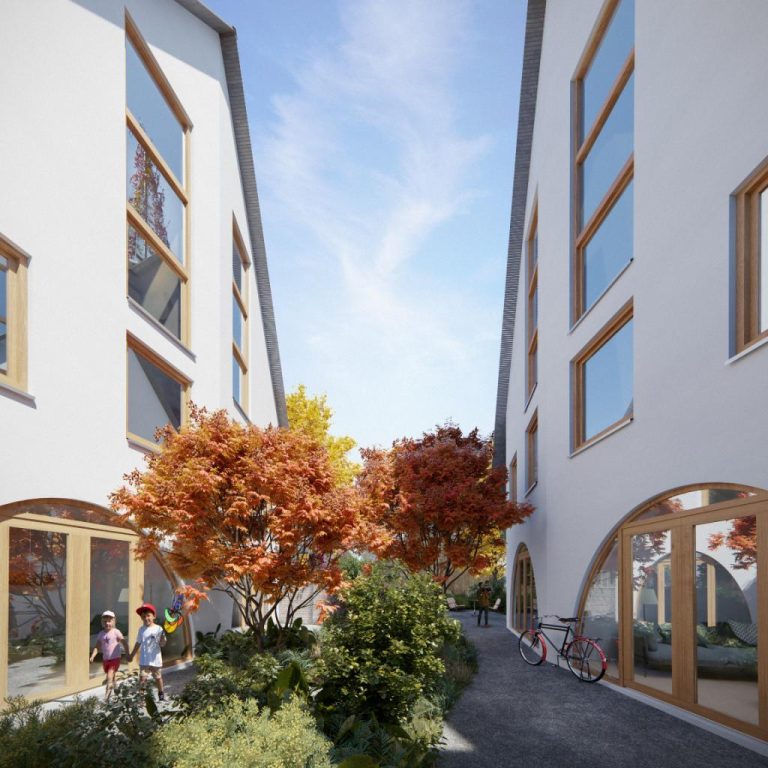

The space between the houses is intended to be a meeting place within the seclusion of the old church walls. (Image: HUM design & development).
About 180 interested people signed up on the website for the four homes. Morkoç expects that the sale will go quickly despite the limitation of the owner occupation clause. The building work will start at the end of this year and is planned to finish at the end of 2022.
Red pointed tower
Anyone squinting at the tower will see the roof of the Juliana Church again with an open groove in the middle. White plastered walls are in contrast to the remaining bricks. But in the evening, the bricks are lit up with LED lights and the old picture of the street with the Juliana Church returns. The reconstructed open pointed tower will be covered with a special species of ivy that will colour the pointed tower green. Once a year in autumn, the leaves change colour and the pointed tower will be bathed in red. This is in remembrance of the fire that instigated everything.
At the end of next year when the new residents occupy the homes, the young architect will have achieved a solution for two burning questions in housing and urban issues: empty religious heritage buildings and the need for affordable starters housing. In Morkoç’s experience, “People in architecture want references, something that has already been done. I hope that Project Juul will be a source of inspiration for the hundreds of empty church buildings that people now don’t know what to do with.”
More information
- Project Juul and HUM design & development (in Dutch): www.wonenbijjuul.nl
- De kerkvernieuwers (the church renewers, in Dutch): www.kerkvernieuwers.nl
- The new RDM premises: www.rdmrotterdam.nl
Do you have a question or comment about this article?
j.w.wassink@tudelft.nl

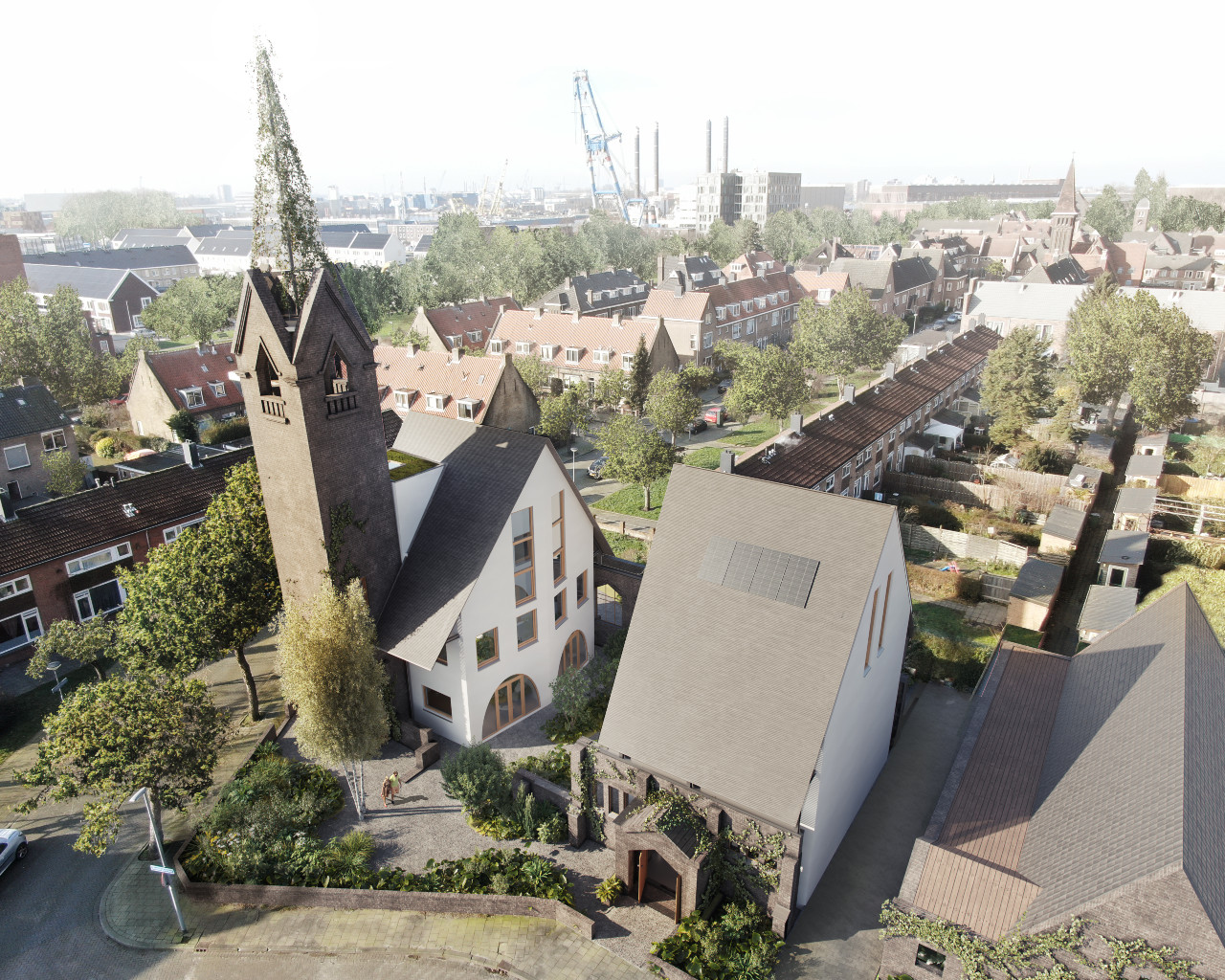
Comments are closed.